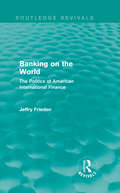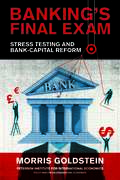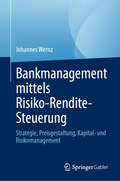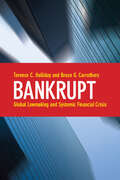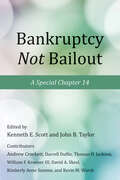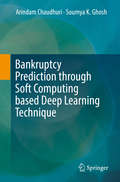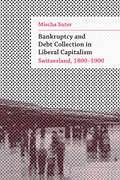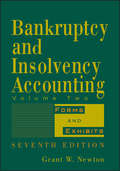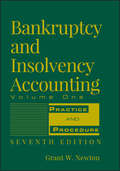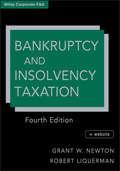- Table View
- List View
Banking on the State: The Financial Foundations of Lebanon (Stanford Studies in Middle Eastern and Islamic Societies and Cultures)
by Hicham SafieddineIn 1943, Lebanon gained its formal political independence from France; only after two more decades did the country finally establish a national central bank. Inaugurated on April 1, 1964, the Banque du Liban (BDL) was billed by Lebanese authorities as the nation's primary symbol of economic sovereignty and as the last step towards full independence. In the local press, it was described as a means of projecting state power and enhancing national pride. Yet the history of its founding—stretching from its Ottoman origins in mid-nineteenth century up until the mid-twentieth—tells a different, more complex story. Banking on the State reveals how the financial foundations of Lebanon were shaped by the history of the standardization of economic practices and financial regimes within the decolonizing world. The system of central banking that emerged was the product of a complex interaction of war, economic policies, international financial regimes, post-colonial state-building, global currents of technocratic knowledge, and private business interests. It served rather than challenged the interests of an oligarchy of local bankers. As Hicham Safieddine shows, the set of arrangements that governed the central bank thus was dictated by dynamics of political power and financial profit more than market forces, national interest or economic sovereignty.
Banking on the World: The Politics of American International Finance (Routledge Revivals)
by Jeffry FriedenThis book, first published in 1987, examines American international finance and banking, and the affect that the United States had in the world economy. This book will be of interest to students of finance and economics.
Banking with Integrity
by Claus Dierksmeier Heiko Spitzeck Michael Pirson 0026Banking with Integrity provides rich and in-depth case studies of banks which were doing well during the financial crisis of 2007-2010. While other banks went bankrupt, were nationalized, or struggled for survival some of the featured cases increased market share, attracted more customers and avoided home evictions of their clients.
Banking's Final Exam: Stress Testing and Bank-Capital Reform (Policy Analyses in International Economics)
by Morris GoldsteinSpurred by the success of the first stress test of US banks toward the end of the global economic crisis in 2009, stress testing of large financial institutions has become the cornerstone of banking supervision worldwide. The aim of the tests is to determine which banks are adequately capitalized under severe economic shocks and to order corrective measures for those that are vulnerable. In Banking’s Final Exam, one of the world’s leading experts on banking regulation concludes that the tests administered on both sides of the Atlantic suffer from fundamental weaknesses, leading to a false sense of reassurance about the safety and soundness of the banking system. Some weaknesses can be corrected within the existing bank-capital regime, but others will require bold reforms—including higher minimum capital requirements for the largest and most systemically-important banks. The banking industry is likely to resist these reforms, but this book explains why their objections do not hold water.
Banking, Lending and Real Estate (Banking, Money and International Finance)
by Claudio Scardovi Alessia BezzecchiThis book deals directly with the risk/return multiple trade-offs coming out of the closely intertwined relationship between banking and real estate. The authors explore how banks could embrace a more proactive approach to make the most of their, mostly ‘long only’, exposure to real estate, and create positive spillover effects on their real estate counterparts and the sector as a whole. It provides a "state of the art" representation and analysis of the strategies that best practices in banking are adopting to manage these issues and plan for a new set of interrelations, driving a "virtuous circle" as opposed to the current one. Banking, Lending and Real Estate is built on the academic knowhow and professional expertise of the authors, who have been researching, writing and working on this joint topic for over a decade. With its pragmatic approach, it allows the reader to capture which leading hedge active and holistic approaches are available today and proven to treat, for example, the banks’ overexposure to this asset class; to manage "unlikely to pay" and sub-performing positions; and to optimize the recovery value coming from the work out of real estate related NPL (and underlying assets). Case studies and relevant examples are provided, leveraging on the authors’ experience in consulting projects in the EMEA region and from working with global, regional and domestic banks and the real estate players acting across its value chain. This book will appeal to both academics and business practitioners within the banking, financial services and real estate sectors, as well as professionals from financial and strategic/industrial advisory working in those fields.
Banking, Projecting and Politicking in Early Modern England: The Rise and Fall of Thompson and Company 1671‒1678 (Palgrave Studies in Economic History)
by Mabel WinterBanking, Projecting, and Politicking uncovers a previously understudied and unacknowledged financial institution in late-seventeenth-century England known as Thompson and Company. Whilst the institution has been briefly mentioned in literary studies focusing on the poet and politician Andrew Marvell, it has never been the sole focus of an economic, financial, commercial, or political study in its own right. As such, nothing is known of how it operated, where it sits in the history of English finance, why it collapsed, or what it can tell us about wider Restoration society and its economic and political culture. Through a microhistorical study, the book reconstructs the institution of Thompson and Company, the social networks of its partners, the identity of its creditors, and the events and circumstances that led to its collapse. The book situates the reconstructed institution within its economic, commercial, financial, and political contexts, using the evidence accrued to question the traditional narrative of financial and commercial development, credit systems, the relationship between economics, finance, commerce and politics, and the place of risk and strategy in gendered relations, credit, and social status. The book will be of interest to academics and students in economic history, financial and business history.
Banking, Risk and Crises in Europe: From the Global Financial Crisis to COVID-19 (Routledge International Studies in Money and Banking)
by Anna Matysek-Jędrych Renata Karkowska Zbigniew Korzeb Paweł NiedziółkaEuropean economies have been plagued by successive crises, from the Global Financial Crisis (GFC) to the COVID-19 pandemic, through to the economic and geopolitical instability in Ukraine. These events, the uncertainty they generate combined with dynamic technological progress and significant sociocultural changes, have profoundly modified the character of modern finance. Understanding what happened, what mechanisms worked, and the reaction of the banking sector, bank customers, and policymakers require an in-depth and structured analysis. This book critically assesses the impact of these events, notably the COVID-19 pandemic, on the performance of the banking sector in Europe and serves as a compendium of knowledge on recent changes in European banking from two perspectives: firstly, European banking transformation, analyzing the process of what has already taken place, in particular, the GFC and COVID-19 crises; secondly, the challenges facing the operations and strategic management of European banks. It identifies specific areas of impact on the activity of commercial banks and the determining factors that will shape the economic and financial condition of banks and their customers – borrowers – in the future. Risk management, particularly credit risk, is a key focus of this volume. Each chapter, implicitly or explicitly, address a variety of questions that can help the reader to understand the complex nature of the transformation of the banking sector. The book provides a structured reference for those concerned with the impact of volatility on the business models of modern banks. As such, it will find a broad audience among students, academics, banking, financial, business, and industry professionals, policymakers, and market regulators.
Bankinter: Growing Through Small and Medium Enterprises
by F. Asis Martinez-Jerez Joshua BellinSurveys the overall sequence of processes needed for the success of a strategy based on customer analytics. In particular, it charts the formulation and implementation of this strategy by a Spanish bank that decided to expand into the Small and Medium Enterprises (SME) segment. Starting with the creation of information necessary for the bank to compete in this segment, it describes the strategic selection of the target customer group, the definition of the product offering, and the organizational changes needed to implement such a strategy.
Bankmanagement mittels Risiko-Rendite-Steuerung: Strategie, Preisgestaltung, Kapital- und Risikomanagement
by Johannes WernzDieses Buch behandelt umfassend und nahtlos Risikomanagement, Produktpreisgestaltung, Kapitalmanagement und Eigenkapitalrendite. Strategische Planung, einschließlich der erforderlichen quantitativen Methoden, ist ein wesentlicher Bestandteil des Bankmanagements und der -kontrolle. Eine gründliche Einführung in die fortgeschrittenen Methoden des Risikomanagements für Kreditrisiko, Gegenparteirisiko, Marktrisiko, operationelles Risiko und Risikoaggregation wird bereitgestellt. Darüber hinaus werden direkt anwendbare Konzepte und Daten wie makroökonomische Szenarien für die strategische Planung und Stresstests sowie detaillierte Szenarien für operationelles Risiko und fortgeschrittene Konzepte für Kreditrisiko in verständlicher Sprache präsentiert. Das Buch hebt die Auswirkungen und Chancen der Basel-III- und Basel-IV-Umsetzungen (ab 2022) hervor, insbesondere in Bezug auf Kapitalmanagement und Eigenkapitalrendite. Eine Fülle von wesentlichen Hintergrundinformationen aus der Praxis, internationalen Beobachtungen und Vergleichen sowie zahlreiche anschauliche Beispiele machen dieses Buch zu einer nützlichen Ressource für etablierte und zukünftige Fachleute im Bankmanagement, Risikomanagement, Kapitalmanagement, Controlling und Rechnungswesen.
Bankminded: Banks as Intimate Agents of Everyday Life in Welfare State Sweden (Palgrave Studies in Economic History)
by Orsi HuszThis open access book explores the history of how banks and banking services have become part of everyday life. Taking welfare state Sweden as its setting, the book identifies key cultural challenges and shows how banks and finance companies made inroads into the workplace, the family, spaces of consumption and the world of social movements while also taking on tasks typically associated with state authorities. Focusing on this ‘bankification of everyday life’ reveals the historical links between the post-war welfare state and the financialised everyday culture of the late twentieth century. This book will be of interest to scholars of economic and cultural history and sociology, as well as those interested in the history of welfare states and the development of commercial surveillance.
Bankrotmaking van die Derde Wêreld
by Elmarié Smal James Morcan Lance MorcanBankrotmaking van die Derde Wêreld is toegewy aan die armes in vergete plekke van die wêreld. Dit vra of die Wêreldbank, die Internasionale Monetêre Fonds, die Verenigde State se Agentskap vir Internasionale Ontwikkeling en ander groot internasionale hulporganisasies die wêreld se armste mense help of belemmer. In hierdie boek word ook gevra of die hulppakkette wat verskaf word, reg is en of dit swendelary is wat ontwerp is om Derde Wêreldlande te onderwerp. Dit stel die kultuur van korrupsie binne die voorgenoemde hulporganisasies bloot en die arrogansie waarmee hulle hul derde wêreldkliënte behandel. ' Die Morcans onthul dat daar 'n onheilspellende verborge agenda is waarvolgens die 'vrygewigheid' wat deur internasionale hulporganisasies uitgebrei word om die ontwikkeling van die Derde Wêreld te ondersteun en om verligting te bied in die geval van natuurrampe, met ernstige bymotiewe kom. Bymotiewe wat ontwerp is om kwesbare nasies te kul. Die leser word herinner aan die ekonomiese treffers wat gewild geword het in John Perkins se topverkoper van 2004. Bekentenisse van 'n Ekonomiese Sluipmoordenaar is nog steeds lewendig en goed - in Afrika in die besonder. By die skryf van hierdie boek is die skrywers gemotiveer deur een sieklike statistiek: 21, 000 mense sterf elke dag van hongersnood. Dit is een persoon elke vier sekondes! Meer siek is die feit dat sulke sterftes onnodig is aangesien daar meer as genoeg rykdom in die wêreld is, want almal moet ten minste die basiese lewensbehoeftes ontvang en daar is meer as genoeg in die Derde Wêreld om dit self organies te onderhou. Teen die tyd dat jy aan die einde van hierdie boek kom, sal jy sien dat daar soveel rykdom in die Derde Wêreld voorkom soos in die Eerste Wêreld. Trouens, terme soos 'Derde Wêreld' en 'verarmde nasies' is in wese verkeerde benamings, omdat dit impliseer dat rykdom en hulpbronne beperk is.
Bankrupt
by Terence C. Halliday Bruce G. CarruthersThe Asian Financial Crisis dramatically illustrated the vulnerability of financial markets in emerging, transitional, and advanced economies. In response, international organizations insisted that legal reforms could help protect markets from financial breakdowns. Sitting at the nexus between the legal system and the market, corporate bankruptcy law ensures that the casualties of capitalism are treated in an orderly way. Halliday and Carruthers show how global actors-including the IMF, World Bank, UN, and international professional associations-developed comprehensive norms for corporate bankruptcy laws and how national policymakers responded in turn. Drawing on extensive fieldwork in China, Indonesia and Korea, the authors reveal how national policymakers contested and negotiated domestic laws in the context of global pressures. The first study of its kind, this book offers a theory of legal change to explain why global/local tensions produce implementation gaps. Through its analysis of globalization, this book has lessons for international organizations and developing and transition economies the world over.
Bankrupt in America: A History of Debtors, Their Creditors, and the Law in the Twentieth Century (Markets and Governments in Economic History)
by Mary Eschelbach Hansen Bradley A. HansenIn 2005, more than two million Americans—six out of every 1,000 people—filed for bankruptcy. Though personal bankruptcy rates have since stabilized, bankruptcy remains an important tool for the relief of financially distressed households. In Bankrupt in America, Mary and Brad Hansen offer a vital perspective on the history of bankruptcy in America, beginning with the first lasting federal bankruptcy law enacted in 1898. Interweaving careful legal history and rigorous economic analysis, Bankrupt in America is the first work to trace how bankruptcy was transformed from an intermittently used constitutional provision, to an indispensable tool for business, to a central element of the social safety net for ordinary Americans. To do this, the authors track federal bankruptcy law, as well as related state and federal laws, examining the interaction between changes in the laws and changes in how people in each state used the bankruptcy law. In this thorough investigation, Hansen and Hansen reach novel conclusions about the causes and consequences of bankruptcy, adding nuance to the discussion of the relationship between bankruptcy rates and economic performance.
Bankruptcy Courts & Procedures
by Pamela Everett NollkamperBankruptcy Courts & Procedures is a comprehensive guide to the entire bankruptcy process, including involuntary, creditor and adversary proceedings. The book also lists fees, filing requirements, names, addresses and telephone numbers for every bankruptcy court in the nation. Written by Pamela Everett Nollkamper, a professional paralegal with decades of experience, Bankruptcy Courts & Procedures provides the tools necessary to guide you through your case whether you're new to the field or an experienced bankruptcy professional. Bankruptcy Courts & Procedures provides information necessary to file in every bankruptcy court nationwide, with filing requirements for all 50 states, the District of Columbia, Puerto Rico and the Virgin Islands.
Bankruptcy Not Bailout: A Special Chapter 14
by John B. Taylor Kenneth E. ScottThis book introduces and analyzes a new and more predictable bankruptcy process designed specifically for large financial institutions—Chapter 14—to achieve greater financial stability and reduce the likelihood of bailouts. The contributors identify and compare the major differences in the Dodd-Frank Title II and the proposed new procedures and outline the reasons why Chapter 14 would be more effective in preventing both financial crises and bailouts.
Bankruptcy Prediction through Soft Computing based Deep Learning Technique
by Arindam Chaudhuri Soumya K. GhoshThis book proposes complex hierarchical deep architectures (HDA) for predicting bankruptcy, a topical issue for business and corporate institutions that in the past has been tackled using statistical, market-based and machine-intelligence prediction models. The HDA are formed through fuzzy rough tensor deep staking networks (FRTDSN) with structured, hierarchical rough Bayesian (HRB) models. FRTDSN is formalized through TDSN and fuzzy rough sets, and HRB is formed by incorporating probabilistic rough sets in structured hierarchical Bayesian model. Then FRTDSN is integrated with HRB to form the compound FRTDSN-HRB model. HRB enhances the prediction accuracy of FRTDSN-HRB model. The experimental datasets are adopted from Korean construction companies and American and European non-financial companies, and the research presented focuses on the impact of choice of cut-off points, sampling procedures and business cycle on the accuracy of bankruptcy prediction models. The book also highlights the fact that misclassification can result in erroneous predictions leading to prohibitive costs to investors and the economy, and shows that choice of cut-off point and sampling procedures affect rankings of various models. It also suggests that empirical cut-off points estimated from training samples result in the lowest misclassification costs for all the models. The book confirms that FRTDSN-HRB achieves superior performance compared to other statistical and soft-computing models. The experimental results are given in terms of several important statistical parameters revolving different business cycles and sub-cycles for the datasets considered and are of immense benefit to researchers working in this area.
Bankruptcy and Debt Collection in Liberal Capitalism: Switzerland, 1800–1900 (Social History, Popular Culture, And Politics In Germany)
by Mischa SuterDrawing on perspectives from anthropology and social theory, this book explores the quotidian routines of debt collection in nineteenth-century capitalism. It focuses on Switzerland, an exemplary case of liberal rule. Debt collection and bankruptcy relied on received practices until they were standardized in a Swiss federal law in 1889. The vast array of these practices was summarized by the idiomatic Swiss legal term “Rechtstrieb” (literally, “law drive”). Analyzing these forms of summary justice opens a window to the makeshift economies and the contested political imaginaries of nineteenth-century everyday life. Ultimately, the book advances an empirically grounded and theoretically informed history of quotidian legal practices in the everyday economy; it is an argument for studying capitalism from the bottom up.
Bankruptcy and Insolvency Accounting, Forms and Exhibits
by Grant W. NewtonWith the rise in the number of mergers and acquisitions taking place in today's business environment, there will undoubtedly be a rise in the number of bankruptcies. Completely updated, Bankruptcy and Insolvency Accounting, Seventh Edition, Volume 2 updates the most recent forms and exhibits as a result of the new Bankruptcy Abuse Prevention and Consumer Protection Act of 2005 (BAPCPA). The process of turning around a troubled business and restructuring its financial aspects is thoroughly described for controllers, CEOs, CFOs and CPAs with small businesses as clients.
Bankruptcy and Insolvency Accounting, Practice and Procedure
by Grant W. NewtonAccountants and financial managers are often the first professionals to realize that a financial problem exists within a corporation but must be familiar with the various alternatives available to clients before they can offer solutions. Completely updated, Bankruptcy and Insolvency Accounting, Seventh Edition, Volume 1 provides detailed information on SOP 90-7 and FASB statements 141, 142, and 144 and revisions made in CSSR 93-1 by CSSR 03-1. The process of corporate restructuring is thoroughly described for controllers, CEOs, CFOs and CPAs with small businesses as clients.
Bankruptcy and Insolvency Taxation
by Grant W. Newton Robert LiquermanThe thousands of mergers, acquisitions, and start-ups that have characterized the past years of business have created an increasing number of corporations in financial trouble: specifically, a shortage of venture capital or quick cash. Consequently, bankruptcy protection is now viewed as a strategic move to protect corporations from their creditors and allow them to reorganize. Fully revised and updated with new case studies and the latest coverage of regulations, Bankruptcy and Insolvency Taxation, Fourth Edition provides the answers to the questions financial managers will have on the tax aspects of bankruptcy strategy.
Bankruptcy and Restructuring at Marvel Entertainment Group
by Benjamin C. Esty Jason S. AuerbachMarvel Entertainment Group is the leading comic book publisher in the United States, with superheros like Spider-Man, the Incredible Hulk, the X-Men, and Captain America. It is also one of the leading manufacturers of sports and entertainment trading cards under the Fleer and Sky Box brand names. In the mid-1990s, it experienced sharp declines in both businesses, causing it to file for bankruptcy in December 1996. This case is set in late January 1997, shortly after Marvel filed its reorganization plan with the bankruptcy court and approximately one month before creditors will have to vote on the plan at the confirmation hearing. Two of the most prominent corporate raiders of the 1980s are pitted against each other for control of the company. On one side is Ronald Perelman, who controls Marvel through his MacAndrews & Forbes holding company. On the other side is Carl Icahn, who controls 25% of Marvel's public debt. Icahn and the other bondholders must decide whether to accept Perelman's plan, to reject it in favor of their own plan, or to sell their bonds before the confirmation hearing. Perelman must decide whether to change the plan in response to the debtholders' threats or to wait and see what happens at the hearing. A rewritten version of another case.
Bankruptcy and the U.S. Supreme Court
by Ronald J. MannIn this illuminating work, Ronald J. Mann offers readers a comprehensive study of bankruptcy cases in the Supreme Court of the United States. He provides detailed case studies based on the Justices' private papers on the most closely divided cases, statistical analysis of variation among the Justices in their votes for and against effective bankruptcy relief, and new information about the appearance in opinions of citations taken from party and amici briefs. By focusing on cases that have neither a clear answer under the statute nor important policy constraints, the book unveils the decision-making process of the Justices themselves - what they do when they are left to their own devices. It should be read by anyone interested not only in the jurisprudence of bankruptcy, but also in the inner workings of the Supreme Court.
Bankruptcy at Caesars Entertainment
by David Chan Kristin MugfordCaesars Entertainment was a large casino operator in the United States that had been purchased in a 2008 leveraged buyout by Apollo and TPG. In January, 2015, Caesars Entertainment Operating Company (CEOC), its largest subsidiary, filed for Chapter 11. This set up a battle between the company and a set of large distressed investors. At issue was not only how to restructure the business and reduce Caesars debt, but also multiple lawsuits alleging that the company had damaged creditors in their quest to preserve equity value. Of particularly focus were a series of transactions that took place during 2013 and 2014 to sell assets from one subsidiary to another and to eliminate a valuable parent guarantee that had been granted to CEOC creditors. This case provides a good example of a variety of "defensive maneuvers" employed by companies and their private equity sponsors to protect a troubled investment.
Bankruptcy for Small Business Owners
by Stephen EliasWipe out business debts and get a fresh start! Small businesses are failing at record rates, and business bankruptcies are on the rise; more than 43,000 were filed in 2008-up 53% over the previous year. Bankruptcy for Small Business Owners helps small businesses assess the financial condition of their business, determine whether they should declare bankruptcy, and offers step-by-step instructions for completing all of the bankruptcy forms and filing them in court. It covers: what business debt and assets (if any) would be impacted by bankruptcy bankruptcy options: Chapter 7, Chapter 13 and Chapter 11, and the eligibility factors and downsides of each "look back" requirements (periods of time during which personal or business actions have created impediments to filing for bankruptcy) automatic stays valuation of business assets (including good will & intellectual property) and shares exemptions what happens when there is personal liability for a house and more. For businesses that are under water and don't want to spend money on a lawyer they can't afford, this book provides all the information they need to handle their own bankruptcy filing.

